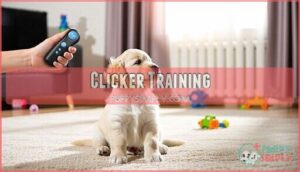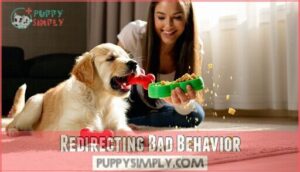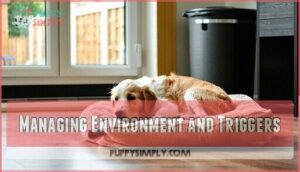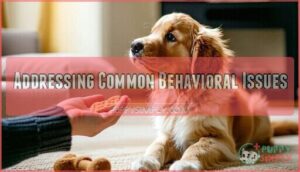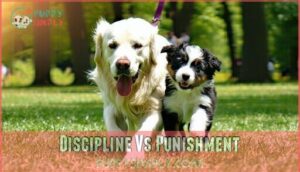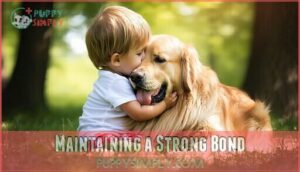This site is supported by our readers. We may earn a commission, at no cost to you, if you purchase through links.
 Disciplining your dog means teaching them boundaries with patience and consistency.
Disciplining your dog means teaching them boundaries with patience and consistency.
Start by identifying bad behavior—like chewing shoes or barking excessively—and redirecting it.
Catch them in the act, say "No" firmly, and offer an appropriate activity, like a chew toy.
Use positive reinforcement to reward good behavior with treats, praise, or playtime.
Avoid yelling or physical punishment; it damages trust and confuses your pup.
Consistency is key—everyone in your household should enforce the same rules.
Pay attention to their needs, too, as boredom or stress often leads to misbehavior.
With time, your dog will learn what’s expected of them.
Curious about addressing specific issues? Keep reading.
Table Of Contents
- Key Takeaways
- Dog Discipline Basics
- How to Discipline Dogs
- Positive Reinforcement Techniques
- Effective Disciplinary Methods
- Managing Environment and Triggers
- Addressing Common Behavioral Issues
- Advanced Training Strategies
- Discipline Vs Punishment
- Teaching Obedience and Boundaries
- Maintaining a Strong Bond
- Frequently Asked Questions (FAQs)
- How do you correctly discipline a dog?
- How do you discipline a dog that doesn’t listen?
- How to correct a misbehaving dog?
- What punishment do dogs hate the most?
- What are the best treats to use for positive reinforcement?
- How do I know when my dog is ready for obedience training?
- What if my dog has separation anxiety?
- What are the best ways to redirect a dog’s behavior?
- How can I tell if my dog is stressed out?
- How can I discipline multiple dogs simultaneously?
- Conclusion
Key Takeaways
- Set clear boundaries and enforce them consistently so your dog knows what’s expected.
- Use positive reinforcement like treats and praise to reward good behavior immediately.
- Redirect unwanted actions to appropriate activities, like giving toys for chewing instead of furniture.
- Avoid yelling or physical punishment as it breaks trust and confuses your dog.
Dog Discipline Basics
Disciplining your dog starts with understanding their behavior and meeting their needs. Clear boundaries and consistent expectations help your dog feel secure and build trust in your guidance.
Clear boundaries and consistent guidance create a secure, trusting bond between you and your dog, fostering better behavior naturally.
Identifying Bad Behavior
Bad behavior in dogs often stems from triggers like boredom, fear, or stress.
Anxiety manifestations might include barking or destructive chewing, while boredom indicators could be restlessness or digging.
Identifying triggers like loud noises or loneliness helps you spot fear responses or stress signals.
Trauma impact from past events may also influence dog behavior issues, requiring careful behavior modification.
Understanding Dog Needs
Understanding dog needs is key to shaping behavior.
Each dog’s exercise requirements, mental stimulation, and socialization importance vary by breed.
Neglecting these can lead to frustration or bad habits.
Feed balanced meals to meet nutritional needs and watch for signs of boredom or anxiety.
Knowing canine psychology helps prevent misbehavior and guides effective dog discipline.
Positive reinforcement, like using praise and treats, is also very helpful.
An animal behaviorist can help if needed, providing expert guidance on positive reinforcement techniques.
Setting Boundaries
Setting boundaries with your dog requires clear communication and consistent rules.
Use consistent training to enforce limits, like keeping them off furniture or out of certain rooms.
Limiting access to off-limits areas and establishing dog routines helps maintain order.
By respecting boundaries through positive reinforcement, you’ll create structure, and consistency builds trust, making dog discipline easier for both you and your pet.
How to Discipline Dogs
Effective dog discipline relies on clear communication and consistent techniques adapted to each dog’s needs.
Here’s how you can address misbehavior thoughtfully:
- Ignore bad behavior by turning away or refusing attention until your dog settles.
- Redirect their focus with toys or commands to replace inappropriate actions like chewing or barking.
- Use timeouts to remove your dog briefly from overstimulating situations, ensuring they understand consequences calmly.
Remember, discipline alternatives vary by breed differences, puppy discipline, or senior dogs, so stay patient with dog training!
Positive Reinforcement Techniques
Using positive reinforcement, you can teach your dog good behavior by rewarding actions you want them to repeat.
Reward your dog’s good behavior consistently to build trust, strengthen your bond, and encourage habits they’ll happily repeat.
This method strengthens your bond and makes learning enjoyable for both of you.
Rewarding Good Behavior
Rewarding good behavior strengthens your bond with your dog through positive reinforcement.
Treat timing is key—reward immediately so your dog links the action with the reward.
Praise effectiveness increases when paired with Toy motivation or Affection value like belly rubs.
Reward consistency is fundamental in reward-based training, ensuring your dog enjoys being rewarded for repeating good behaviors reliably.
This approach aligns with operant conditioning fundamentals, where good behavior leads to rewards.
Using Treats and Praise
Using treats and praise strengthens your bond and motivates your dog.
Positive reinforcement works when reward timing is spot-on—offer treats or praise immediately after good behavior.
Vary praise tones to keep it engaging, and remember that consistency is key; rewards teach boundaries and habits.
Consider exploring various training treat options to find what motivates your dog most, and adapt rewards to your dog’s motivation levels for effective, reward-based training.
They’ll connect actions to outcomes quickly!
Clicker Training
Clicker training is a precise, reward-based method that strengthens dog obedience through positive reinforcement.
Start with a clicker introduction by associating the click with a treat.
Use target training to teach specific actions, guiding your dog step-by-step.
Shaping behavior helps refine complex tasks.
As they learn, practice fading clicks, substituting praise for the click, creating lasting, consistent results.
Effective Disciplinary Methods
Disciplining your dog effectively requires clear actions that guide them toward better behavior without causing fear or confusion.
By using techniques like attention withdrawal, timeouts, and redirection, you can correct unwanted actions while maintaining a positive and trusting relationship.
Attention Withdrawal
Sometimes, ignoring attention-seeking behavior works wonders.
When your dog jumps or barks excessively, try breaking eye-contact, leaving the room, or turning away.
Attention withdrawal shows them that bad behavior doesn’t get the reward they’re after.
Withholding affection may feel tough, but it’s effective for dog training.
Pair this method with positive reinforcement to encourage better habits, and remember that withholding affection is a key part of this approach.
Timeouts and Consequences
A timeout is an effective discipline strategy for stopping bad behavior without aggression.
Use a quiet space as the timeout location, lasting 5–15 seconds, depending on the consequence severity.
Consistency is key—repeat the timeout for repeated misbehavior, and many owners find a dog timeout crate helpful for this purpose.
Avoid overuse to maintain its impact, and consider alternative consequences, like attention withdrawal, which can also reinforce boundaries while keeping discipline humane and productive.
Redirecting Bad Behavior
When your dog misbehaves, redirecting behavior works wonders.
Offer Alternative Activities like Interactive Games or Puzzle Toys to shift their focus.
A Training Command followed by positive reinforcement helps reinforce good choices.
Chew Toy Options can save your shoes from destruction.
Remember, dog training is about patience.
Reward calm behavior quickly so they connect actions to outcomes, shaping better habits.
Managing Environment and Triggers
You can prevent many behavioral issues by managing your dog’s environment and removing triggers.
Simple changes, like keeping tempting items out of reach and creating consistent routines, help your dog feel secure and reduce misbehavior, which can be achieved by making these simple adjustments to daily life.
Removing Temptations
You can prevent bad behavior by removing temptations and setting up a safe environment.
Limit access to off-limits items, like shoes or furniture, to stop destructive chewing. Store valuables securely and puppy-proof spaces where accidents might happen.
A great way to manage their space is by using safe, contained enclosures. Always leave chew toys within reach to redirect your dog’s energy.
- Limit Access: Use gates or barriers.
- Secure Valuables: Store shoes safely.
- Puppy-Proofing: Remove triggers effectively.
Establishing Routines
Establishing routines keeps your dog calm and happy.
Stick to consistent schedules for potty breaks, feeding times, and exercise needs.
Predictable activities create structure and reduce anxiety.
Use regular times for meals and walks to support training and build trust.
| Routine | Why It Helps | Example |
|---|---|---|
| Feeding Times | Fosters predictability | Same mealtime daily |
| Potty Breaks | Prevents accidents | Frequent outdoor trips |
| Exercise Needs | Releases energy | Daily play sessions |
Preventing Destructive Behavior
Your furniture’s safety demands a bit of proactive planning.
To curb destructive habits:
- Limit access to risky areas or valuable items.
- Supply durable chew toys for proper chewing opportunities.
- Schedule routine exercise to burn off energy and prevent boredom.
- Use crate training during short absences, providing security and reducing separation anxiety.
Consistency in these practices guarantees effective dog training.
Addressing Common Behavioral Issues
When your dog displays common behavioral issues like barking, chewing, or separation anxiety, it’s important to understand the reasons behind their actions.
By addressing these behaviors consistently and with the right techniques, you can help your dog build better habits while feeling secure and loved, which is crucial for addressing issues like separation anxiety.
Barking and Whining
To curb barking problems and whining, start by recognizing anxiety signals or breed tendencies.
Excessive barking can stem from boredom or attention-seeking.
Use firm commands, reward silence, and ignore whining.
Consistency matters.
Redirect behaviors with training solutions like "quiet" commands while remaining calm.
| Problem | Cause | Solution | Outcome |
|---|---|---|---|
| Excessive Barking | Anxiety or boredom | Reward silence | Reduced barking |
| Attention Seeking | Lack of engagement | Ignore unwanted behavior | Better focus |
| Anxiety Signals | Stress or fear | Calm environment | Relaxed behavior |
| Breed Tendencies | Natural vocalization | Training solutions | Controlled noise levels |
Chewing and Digging
Chewing issues and digging solutions start with understanding why dogs act out.
Boredom often fuels destructive behavior.
Redirect instincts with these tips:
- Offer chew toys to replace chewing on furniture.
- Create a digging zone in your yard for safe digging.
- Provide regular mental and physical boredom busters.
- Supervise until your dog learns acceptable behaviors.
Consistency builds trust and curbs chaos.
Positive reinforcement, a key element of treat based training, can further help in modifying these behaviors, using positive reinforcement.
Separation Anxiety
Separation anxiety can overwhelm dogs, but gradual desensitization and calming techniques help.
Identify anxiety triggers, then leave briefly with treats or toys to ease stress. Increase alone time slowly.
Exercise beforehand reduces dog anxiety, promoting calm. For severe cases, consult a dog training professional.
Medication options or professional intervention may also address persistent dog behavior issues effectively.
Advanced Training Strategies
To effectively address challenging behaviors, you’ll need strategies that go beyond basic training.
These advanced methods focus on consistency, addressing potential medical issues, and knowing when to seek professional guidance.
Professional Help and Guidance
If your dog’s behavior feels unmanageable, a professional animal behaviorist or obedience trainer can help.
Behaviorist consultations target anxiety, aggression, or fear, while pet psychologists explore emotional roots.
Specialized training builds trust and focus.
A veterinary reviewer may assess for medical causes or recommend medication options, providing effective solutions while avoiding legal liabilities tied to risky behaviors.
Addressing Underlying Medical Issues
Behavior changes can signal medical problems like thyroid imbalances, incontinence causes, or dietary sensitivities.
Pain indicators, such as aggression or anxiety, might point to hidden issues.
Cognitive decline in older dogs often impacts behavior.
Early diagnosis is vital—veterinarians can pinpoint problems and recommend treatment, addressing medical conditions guarantees your dog’s comfort and prevents misunderstandings of their actions, ensuring a proper diagnosis.
Consistency and Patience
Effective dog training demands consistency and patience. Routines create structure, helping your dog understand expectations.
Stick with it to avoid regression and guarantee long-term success. Gradually, you’ll see improvement. One can begin by teaching dogs to obey simple commands.
- Use consistent reinforcement schedules to shape good habits.
- Maintain realistic expectations; progress takes time.
- Celebrate small wins to build momentum.
Dog discipline consistency fosters trust, making the journey rewarding for you both.
Discipline Vs Punishment
In the context of guiding your dog’s behavior, it’s important to understand the difference between discipline and punishment.
Discipline focuses on teaching and guiding, while punishment often causes fear and confusion, which can harm your relationship with your dog.
Negative Reinforcement
Negative reinforcement isn’t punishment, but it’s tricky.
Timing matters—you must stop the discomfort immediately as the dog responds correctly.
Ethical concerns arise if intensity levels cause a scared or stressed pet.
Consistency is key, but risks include avoidance-driven behavior.
Explore alternatives like rewarding good actions instead of relying on unpleasant stimuli.
Here’s a quick comparison:
| Technique | Effectiveness | Risks | Ethical Concerns |
|---|---|---|---|
| Negative Reinforcement | Moderate (Situational) | Stress, Avoidance | High |
| Positive Reinforcement | High | Minimal | Low |
| Timeouts | Moderate | Minimal | Low |
| Redirecting Behavior | Moderate to High | Situational | Low |
Positive Punishment
Adding aversives, like a sharp noise or spray bottle, can interrupt bad habits when done carefully. Timing matters—your reaction must align with the behavior. Keep intensity levels low to avoid fear or confusion.
Potential risks include ethical concerns, like damaging trust. Positive punishment stops actions but doesn’t teach alternatives. Reward good behavior alongside correcting mistakes for better results.
| Technique | Effect | Risk | Alternative |
|---|---|---|---|
| Sharp noise | Stops action instantly | May cause fear | Use calm redirection |
| Spray bottle | Interrupts unwanted behavior | Breaks trust | Reward calm alternatives |
| Physical restraint | Halts persistent misbehavior | Creates stress | Prioritize training cues |
| Ignoring signals | Discourages attention-seeking acts | Increased confusion | Combine with rewards system |
Avoiding Harmful Methods
Avoid outdated techniques like shock collars or physical punishment—they can harm your dog and damage trust.
Crating as punishment is confusing for dogs since crates should feel safe. Dominance theory doesn’t reflect modern dog training methods.
Focus on positive training and using reward-based strategies. A calm, consistent approach helps teach discipline without fear or distress.
| Method | Why to Avoid | Alternative Approach |
|---|---|---|
| Shock Collars | Causes fear and confusion | Reward-based training |
| Physical Punishment | Damages trust, can cause aggression | Positive reinforcement |
| Crating Punishment | Confuses and stresses the dog | Establish safe spaces |
Teaching Obedience and Boundaries
Teaching your dog obedience and boundaries is essential for a well-behaved companion.
By using clear commands and consistent actions, you’ll help your dog understand what’s expected while strengthening your bond.
Voice Commands and Tone
Using calm commands and consistent tone of voice helps dogs understand you clearly.
Avoid shouting or scolding, as it confuses them. Make certain your command phrasing is simple and direct.
Here’s how to improve:
- Use short verbal cues like "Sit" or "Stay."
- Keep command clarity by speaking confidently.
- Maintain tone consistency.
- Avoid emotions in commands, ensuring a consistent tone is key to effective communication.
Toy Removal and Withholding Attention
If your dog’s misbehavior stems from attention-seeking or resource guarding, toy deprivation and ignoring can teach boundaries.
Gently take away toys tied to bad behavior and withhold attention briefly.
Withdrawal duration depends on their response, but be firm yet calm.
Ignoring misbehavior, paired with redirection, helps them understand limits while showing that good behavior earns your attention again, through a method of withhold attention.
Setting Clear Expectations
Consistency is key in dog discipline training.
Set defined boundaries with unambiguous signals, so your dog knows what’s expected.
Predictable outcomes, like praise for sitting or a timeout for jumping, create clear communication, and reinforce good behavior through positive reinforcement, and use redirection to address missteps.
Dog discipline consistency builds trust and makes setting boundaries an effective part of your routine, using positive reinforcement.
Maintaining a Strong Bond
Maintaining a strong bond with your dog is essential for effective discipline and long-term trust.
By focusing on mutual respect and positive interactions, you can encourage better behavior while strengthening your relationship.
Building Trust and Respect
Building trust with your dog starts with mutual understanding and consistent communication.
Use positive interactions, like reward-based training and respectful handling, to foster an emotional connection.
Reinforce good behavior through positive reinforcement to strengthen dog trust.
Every moment spent bonding builds your relationship, helping your pet feel secure and connected.
Clear signals and actions show reliability, deepening your dog’s confidence.
Encouraging Good Behavior
Shaping behaviors starts with rewarding good actions.
Keep treats handy to reinforce positive associations instantly.
Positive reinforcement builds confidence in your dog while teaching socialization skills and proper habits.
Mental stimulation, like puzzle toys or games, can prevent boredom and encourage good behavior.
Reward small wins consistently, as rewards strengthen understanding and trust, making training enjoyable for both you and your dog, through positive reinforcement and mental stimulation.
Strengthening The Pet-Owner Relationship
Encouraging good behavior sets the foundation, but strengthening your relationship with your dog takes it further.
Build trust through consistent praise and mutual respect. Focus on rewarding progress rather than perfection.
Here’s how:
- Use reward-based training to reinforce trust and connection.
- Include playful, joyful learning to deepen your bond.
- Practice dog bonding by prioritizing daily quality time.
Frequently Asked Questions (FAQs)
How do you correctly discipline a dog?
Picture your dog enthusiastically waiting for your response—use a calm, firm tone and redirect unwanted behavior.
Timing is everything; address missteps immediately.
Reward good behavior with praise or treats for clarity and trust-building.
How do you discipline a dog that doesn’t listen?
Stay calm but firm.
Use clear commands like “No” or “Stop” paired with immediate redirection to correct behavior.
Stay consistent, reward good actions, and consider professional help if they persistently ignore discipline efforts.
How to correct a misbehaving dog?
Correct your dog by quickly addressing bad behavior with a firm "No" or redirection to a positive activity.
Stay consistent, use timeouts if needed, and reward good behavior immediately to reinforce expectations.
What punishment do dogs hate the most?
Dogs hate being ignored more than anything.
Withholding attention when they misbehave sends a clear message.
Turning away, breaking eye contact, or stopping play can effectively discourage bad behavior without causing fear or confusion, and this method is particularly useful as it sends a message without causing harm.
What are the best treats to use for positive reinforcement?
Soft, bite-sized treats, like small pieces of chicken, cheese, or commercial training treats, work best.
Choose something special your dog doesn’t get often.
Make sure it’s easy to chew and safe for their size.
How do I know when my dog is ready for obedience training?
About 93% of dogs thrive with structured training.
When your dog focuses on you, follows simple cues like "sit," or shows enthusiasm to learn, it’s time to introduce obedience training for positive growth.
What if my dog has separation anxiety?
Separation anxiety can be tough.
Try leaving for short periods to ease their stress, providing toys or calming scents.
Stick to routines, and consider professional help if needed.
Consistency, patience, and understanding make the difference!
What are the best ways to redirect a dog’s behavior?
Redirect behavior by catching it early, offering a toy or command as an alternative.
Stay calm, consistent, and upbeat.
Reward the desired action immediately, showing them the right choice pays off every time.
How can I tell if my dog is stressed out?
Look for signs like excessive barking, pacing, hiding, or trembling.
A stressed dog might also show destructive behavior, lose appetite, or have accidents indoors.
Pay attention to changes in their habits or demeanor.
How can I discipline multiple dogs simultaneously?
Handle multiple dogs by staying consistent and addressing misbehavior immediately.
Use clear voice commands and separate timeouts if needed.
Reward good behaviors to reinforce training.
Stay calm and make certain each dog understands expectations individually.
Conclusion
Think of training your dog as planting seeds of trust and understanding—it requires care and consistency.
By learning how to discipline a dog properly, you’re building a relationship grounded in respect.
Focus on setting clear boundaries, using positive reinforcement, and addressing their needs to prevent misbehavior.
Avoid punishment that damages trust, and instead, redirect actions with patience.
Over time, your consistent efforts will shape a happy, well-behaved dog that thrives within your guidance.
- https://www.akc.org/expert-advice/training/how-you-may-accidentally-be-encouraging-bad-behavior/
- https://www.aspca.org/pet-care/dog-care/common-dog-behavior-issues/mouthing-nipping-and-play-biting-adult-dogs
- https://vetmed.illinois.edu/pet-health-columns/excessive-barking/
- https://www.psychologytoday.com/us/blog/canine-corner/201205/is-punishment-effective-way-change-the-behavior-dogs
- https://www.preventivevet.com/dogs/ignoring-bad-behavior-in-dogs





